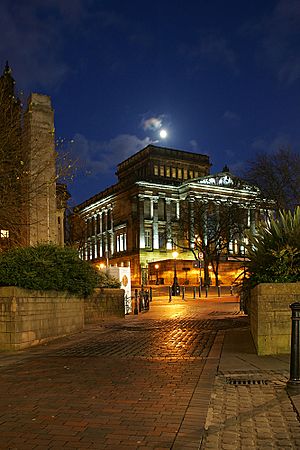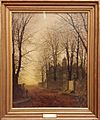Harris Museum facts for kids

The Harris building
|
|
| Lua error in Module:Location_map at line 420: attempt to index field 'wikibase' (a nil value). | |
| Established | 1893 |
|---|---|
| Location | Market Square, Preston, England |
| Type | Art Gallery and Public Library |
|
Listed Building – Grade I
|
|
| Official name: Harris Public Library, Museum and Art Gallery | |
| Designated: | 12 June 1950 |
| Reference #: | 1207306 |
The Harris Museum is a very special building in Preston, Lancashire, England. It is a "Grade I-listed" building, which means it's super important and protected. A man named Edmund Harris started it in 1877. Today, it's a museum that shows off local history and beautiful art. It also has a public library inside.
Contents
History of the Harris Museum
In the 1800s, towns could collect money to build libraries. The people of Preston really wanted a big museum and library. They started raising money in 1850.
In 1877, a lawyer from Preston named Edmund Robert Harris left a lot of money in his will. He gave £300,000 to create a trust. This money was for a public library, museum, and art gallery in Preston.
Early Libraries and Museums
The first lending library in Preston opened in 1879. It was in the basement of the Town Hall. A public museum also opened on Cross Street in 1880. Both were very popular.
Because they were so successful, the council decided to build a new, bigger home for them. Work on the new museum building began in 1882. The Harris Museum officially opened its doors in 1893.
Design of the Building
The Harris Museum was designed by a local architect named James Hibbert. He chose a Neo-Classical style for the building. This style was a bit different from the popular Gothic Revival style of the 1880s. Many other buildings in Preston, like the old Town Hall, used the Gothic style.
Outside the Harris Museum
The outside of the building shows Hibbert's idea of Neo-Classicism. It looks simple, balanced, and very detailed. Unlike some other famous buildings in this style, like the British Museum in London, the Harris Museum does not have big steps leading up to it. Instead, you can enter directly from the ground on each side.
A large triangular section, called a pediment, is at the front of the building. It has a sculpture inspired by Raphael's famous painting, The School of Athens. A sculptor from London, Edwin Roscoe Mullins, created this artwork. It shows the ancient Athenian leader Pericles in the middle, surrounded by twelve other men. This sculpture is considered Mullins' most important work.
Below the pediment, you can read the words: To Literature, Arts and Science. There are also other sayings along the sides of the building. One says: "on Earth there is nothing great but man : in man there is nothing great but mind." On the top tower, there is a quote in Ancient Greek.
Six tall, fluted columns support the pediment. These columns lead down to a raised entrance area that looks out over the Flag Market.
Inside the Harris Museum
The inside of the building has a huge central hall. It rises over 120 feet from the ground floor all the way to the ceiling of the tower. Besides the ground floor, there are three upper floors. These floors have balconies that look down onto the central hall. Each floor also has rooms for collections and exhibitions.
The inside design uses ideas from Ancient Greece, Assyria, and Egypt. You can see columns and mosaic floors. There were also copies of old Greek and Roman sculptures. These sculptures were meant to show the "world’s greatest achievements in art." Today, only the Greek and Assyrian friezes on the upper floors remain. Also, a copy of Lorenzo Ghiberti's Gates of Paradise is still on the ground floor.
A special swinging weight, called a Foucault pendulum, hangs in the central hall. It goes through all the floors. Below it is a butterfly-shaped plate marked with the hours of the day. Because the Earth spins, this pendulum acts like a decorative and fairly accurate clock. The building also has plaster copies of classical friezes. A 19th-century copy of the Baptistery doors from Florence is on the ground floor. These were part of the original design by James Hibbert.
Museum Collections
The Harris Museum has many different collections. These include fine art, decorative art, costumes, textiles, and history. There are also collections about archaeology and local history.
Discover Preston Gallery
The museum has a permanent history gallery called Discover Preston. This gallery tells the story of Preston. It also has a Discovery Room that shows off other parts of the museum's collections. A highlight in the Discovery Room is the complete skeleton of the Poulton Elk. This elk lived 13,500 years ago during the Ice Age. It has two man-made barbed points stuck in its bones. This is the oldest sign of humans living in Lancashire.
Art Collections
The fine art collection has over 800 oil paintings. These include works by famous artists like Richard Ansdell, George Frederick Watts, and Lucian Freud. There are also paintings by local artists such as Anthony Devis. The decorative art collection includes British ceramics and glass. These are shown in the Ceramics and Glass Gallery. The museum also features modern art shows by artists from around the world.
The Harris Library
The Harris building is also home to Preston City's Public Library. This library is managed by Lancashire County Council. The first librarian of the Harris Free Public Library was William Bramwell. He retired in 1916 when he was eighty-one years old.
The Harris library holds important book collections. One is the Shepherd Collection, given to Preston by Dr Richard Shepherd in 1761. The library also has local history materials, old journals, rare books, and art books. The Spencer collection of illustrated children's books is also here. When the Harris opened, William Bramwell was also the librarian for the Dr Shepherd Library. This collection found its home at the Harris after being in different places around town.
Gallery
-
The pediment, with the central figure of Pericles
-
Copy of The Gates of Paradise - the east doors of The Florence Baptistery.
-
Scapa Flow by B. F. Gribble, depicting the surrender of the German High Seas Fleet at Scapa Flow on 18 November 1918, oil on canvas, 1920
Renovation Project: #HarrisYourPlace
The Harris Museum has been undergoing a big renovation project called #HarrisYourPlace. In October 2020, plans for this £10.7 million project were submitted. The goal was to make the Harris the UK’s first "blended museum, art gallery, and library."
This project included important work to fix the roof, stonework, and basement. These repairs helped solve a long-standing damp problem in the building. The renovation also uncovered some of the Harris’ original architectural details that had been hidden. For example, an original entrance way was reopened to make the building easier to access. A new lift and ground floor toilet also improved access for visitors with disabilities. A new staircase replaced the old fire exit stairs.
These works were in addition to a £150,000 Children's Place scheme. This special area was scheduled to open in 2024. It redeveloped the children's library space. It also improved facilities for school groups and families.
See also
- Listed buildings in Preston, Lancashire













